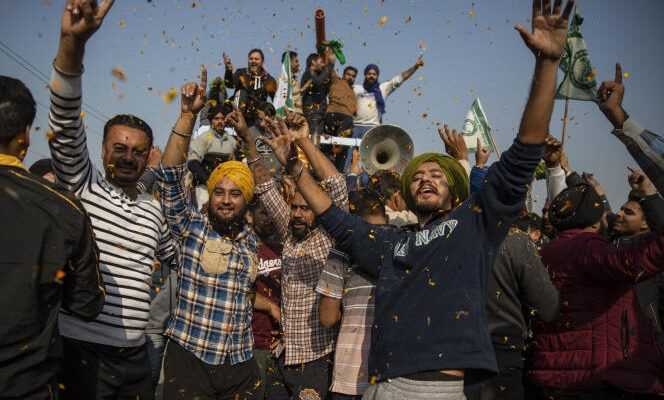After a year of mobilization and an ultimately victorious struggle, they returned to their fields. Thousands of Indian farmers were packing their belongings and dismantling tent villages on Saturday, December 11, on the outskirts of New Delhi, in order to return home after a year of protests against the government’s agrarian policies. Hundreds of them were dancing and celebrating their ” Victoire “, Saturday morning, when the roadblocks were lifted and their makeshift shelters were dismantled on major highways.
Prime Minister Narendra Modi had last month passed parliament to repeal three land reforms that protesters said would allow private companies to control the country’s agricultural sector. However, the protesters initially refused to leave their camps, putting forward other demands, such as a guarantee of fixed minimum prices on their agricultural products.
The government has promised to set up a commission on the subject and is committed to stopping the prosecution of farmers who burn crop stubble, accused of polluting the air in New Delhi every winter.
Biggest crisis for Narendra Modi’s government
The authorities also agreed to pay compensation to the families of hundreds of farmers who they say died during the protests, as well as to stop criminal proceedings against the protesters.
This movement of farmers, the biggest crisis for the government of Mr. Modi since coming to power, underlines both the structural crisis experienced by peasant agriculture and the lack of empathy and dialogue on the part of the Prime Minister. , who had however promised, during his election in 2014, to double their income by 2022.
Farmers make up almost half of the population – 650 million Indians, but only 14% of gross domestic product (GDP). They hold smaller and smaller plots and are increasingly in debt under the pressure of an intensive production method resulting from the “green revolution” of the 1960s.
The agricultural laws wanted by Mr. Modi were passed in September 2020 to allow farmers to sell their production to buyers of their choice, rather than turning exclusively to state-controlled markets ensuring them a minimum support price ( PSM) for certain foodstuffs. Many small farmers were opposed to it, believing themselves threatened by this liberalization which, they said, risked forcing them to sell off their goods to large companies.
After protests in Punjab and Haryana in the north of the country, tens of thousands of farmers headed for the capital, where they were violently pushed back by police, marking the start of a deadlock between two parties that lasted a year.
Since his re-election in May 2019, Mr. Modi has played a strategy of tension, exacerbating antagonisms to discredit opponents of his reforms. In December 2019, a law granting Indian nationality to refugees, unless they are Muslims, sparked a protest movement of unprecedented scale across the country. For months, Indians had taken to the streets and the protest had ended only because of the arrival of the Covid-19 epidemic and the general containment ordered by the Prime Minister.
